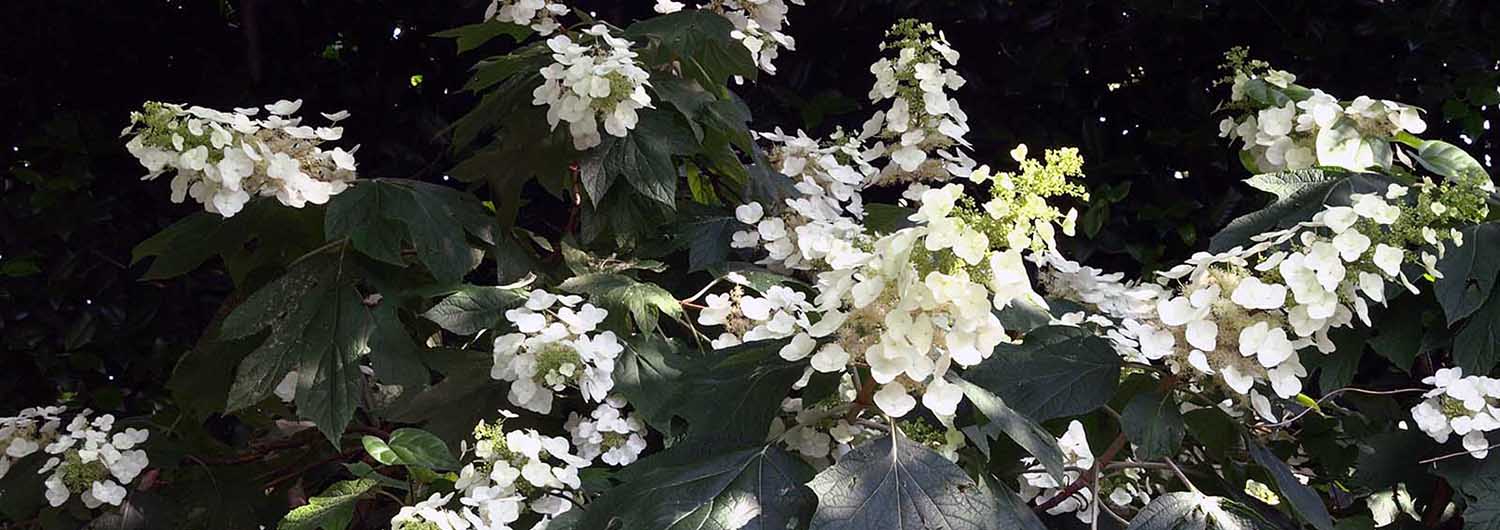Hydrangea quercifolia
oakleaf hydrangea
Hydrangeas are mainstays in gardens throughout much of the United States. Their cheery flowers and shade tolerance make them invaluable additions to the landscape. Although only a few species are well represented in most western landscapes, the genus ranges from small shrubs to plants of almost treelike proportions and scrambling vines. In mild climates, some species are evergreen while others are just barely woody plants at all and are almost closer to herbaceous perennials.
When most people think of hydrangeas though, they invariably picture the Asian species and our own natives often receive short shrift. Hydrangea species can be found in high numbers in Asia but are also represented in North, Central, and South America as well. On the east coast of the United States both Hydrangea arborescens and H. quercifolia are found.
Hydrangea quercifolia (hydrangea from the Greek for water jar in reference to the fruit shape and quercifolia from the genus name Quercus or oak and folia for leaf in reference to the oak-like leaf shape) or oakleaf hydrangea grows naturally from North Carolina and Tennessee south to Florida and west to Louisiana. It grows as an understory plant often along the edges of woodlands and streams. It makes a relatively large shrub in the wild and can often grow to 10'. There is a great deal of diversity among plants growing in the woods and many have been selected for different traits from size to flower length to fall color, and other characteristics.
Oakleaf hydrangea is a fairly coarse shrub which can make it difficult to fit into smaller landscapes. It bears large leaves with deep lobes much like a red oak. Leaf color ranges from glossy, deep green to matte green and often turns to spectacular burgundy and red in the fall. The stout stems have orange exfoliating bark and the winter appearance can be quite attractive after the leaves have dropped. The flowers are held in late spring on erect to nodding panicles which can be as long as 14" on some selections. The white, sterile florets cover the small, fertile flowers to a great degree and while starting creamy white turn to pinkish-rose then tan and are persistent on the plant.
Massing oakleaf hydrangea is a particularly effective way to use them in a landscape where there is room. They can also be used as part of shrub borders and as specimens in woodland gardens. Oakleaf hydrangeas are tough performers in the landscape with few insect or disease problems. They are happiest in part shade with a moist root zone but will tolerate considerable sun and dry soil once they are well established although they will often look wilted by midday in sunny, dry areas. Never fear, they will generally perk back up by the next morning.
While the species is a very nice plant, the selections of H. quercifolia are typically much superior. Some of our favorite plants currently growing at the JCRA include the following:
'Alice' – This is a large growing plant with huge nodding panicles of flowers and large individual florets and excellent fall color. Introduced by Michael Dirr from the UGA campus.
'Alison' – Another Michael Dirr introduction from the UGA campus, this cultivar grows almost to the same size as 'Alice' with slightly smaller panicles that are held upright.
'Flemygea' (Snow Queen™) – This is a somewhat compact shrub from Princeton Nurseries to about 6' with very large, dense flower panicles held very upright. This form supposedly holds up very well in more sun and is very cold tolerant, growing well into zone 5 once established.
'Little Honey' – Perhaps one of the most distinct cultivars, 'Little Honey' emerges with bright gold foliage that softens throughout the summer on a compact plant to about 5' tall. The color is best in dappled shade and can burn in dry, sunny spots. Flowers are relatively small but become somewhat lost in the bright foliage anyway. Small plants may need two to three years before they really start growing well but are worth the wait.
A few newer selections which look very promising but that we have not grown for long enough to truly evaluate include:
'Ice Crystal' – This new selection is notable for its compact size with upright cones of white flowers. The jury is still out on whether this will be a big departure from the tried and true 'Pee Wee'.
'Munchkin' – This selection from the USDA breeding program of Sandra Reed is a true dwarf with leaves one third the size of typical H. quercifolia on upright stems with short internodes. The flower panicles are held just above the foliage in 6" panicles.
'Ruby Slippers' – Another compact form from Sandra Reed's breeding program, this plant has much longer flower panicles that emerge white but quickly turn to pink and then deep rose as they mature.

